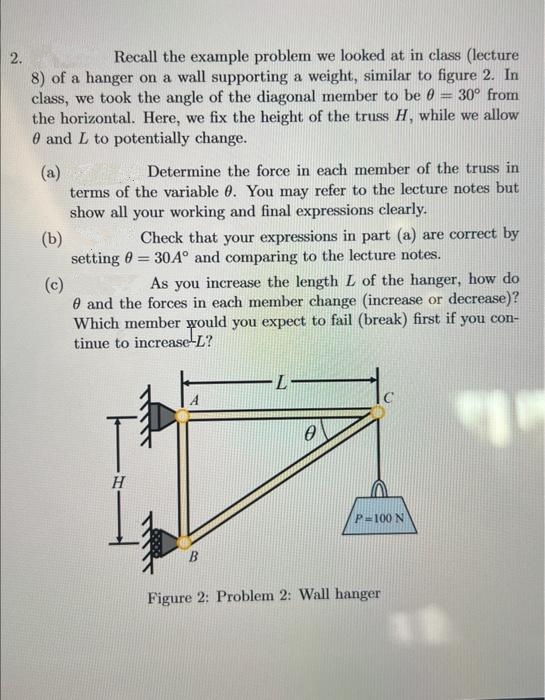2. Recall the example problem we looked at in class (lecture 8) of a hanger on a wall supporting a weight, similar to figure 2. In class, we took the angle of the diagonal member to be 0 = 30° from the horizontal. Here, we fix the height of the truss H, while we allow and L to potentially change. (a) Determine the force in each member of the truss in terms of the variable 0. You may refer to the lecture notes but show all your working and final expressions clearly. (b) (c) setting Check that your expressions in part (a) are correct by 30A and comparing to the lecture notes. H = As you increase the length L of the hanger, how do and the forces in each member change (increase or decrease)? Which member would you expect to fail (break) first if you con- tinue to increase-L? 1 B L- P-100 N Figure 2: Problem 2: Wall hanger
2. Recall the example problem we looked at in class (lecture 8) of a hanger on a wall supporting a weight, similar to figure 2. In class, we took the angle of the diagonal member to be 0 = 30° from the horizontal. Here, we fix the height of the truss H, while we allow and L to potentially change. (a) Determine the force in each member of the truss in terms of the variable 0. You may refer to the lecture notes but show all your working and final expressions clearly. (b) (c) setting Check that your expressions in part (a) are correct by 30A and comparing to the lecture notes. H = As you increase the length L of the hanger, how do and the forces in each member change (increase or decrease)? Which member would you expect to fail (break) first if you con- tinue to increase-L? 1 B L- P-100 N Figure 2: Problem 2: Wall hanger
International Edition---engineering Mechanics: Statics, 4th Edition
4th Edition
ISBN:9781305501607
Author:Andrew Pytel And Jaan Kiusalaas
Publisher:Andrew Pytel And Jaan Kiusalaas
Chapter10: Virtual Work And Potential Energy
Section: Chapter Questions
Problem 10.62P: The bar ABC is supported by three identical, ideal springs. Note that the springs are always...
Related questions
Question
3

Transcribed Image Text:2.
Recall the example problem we looked at in class (lecture
8) of a hanger on a wall supporting a weight, similar to figure 2. In
class, we took the angle of the diagonal member to be 0 = 30° from
the horizontal. Here, we fix the height of the truss H, while we allow
0 and L to potentially change.
(a)
Determine the force in each member of the truss in
terms of the variable 0. You may refer to the lecture notes but
show all your working and final expressions clearly.
(b)
(c)
Check that your expressions in part (a) are correct by
setting = 30A° and comparing to the lecture notes.
As you increase the length L of the hanger, how do
and the forces in each member change (increase or decrease)?
Which member would you expect to fail (break) first if you con-
tinue to increase L?
1
H
L-
0
P=100 N
Figure 2: Problem 2: Wall hanger
Expert Solution
This question has been solved!
Explore an expertly crafted, step-by-step solution for a thorough understanding of key concepts.
Step by step
Solved in 2 steps with 5 images

Knowledge Booster
Learn more about
Need a deep-dive on the concept behind this application? Look no further. Learn more about this topic, mechanical-engineering and related others by exploring similar questions and additional content below.Recommended textbooks for you

International Edition---engineering Mechanics: St…
Mechanical Engineering
ISBN:
9781305501607
Author:
Andrew Pytel And Jaan Kiusalaas
Publisher:
CENGAGE L

International Edition---engineering Mechanics: St…
Mechanical Engineering
ISBN:
9781305501607
Author:
Andrew Pytel And Jaan Kiusalaas
Publisher:
CENGAGE L